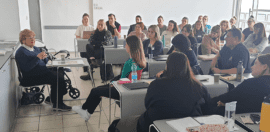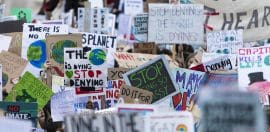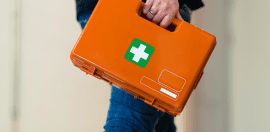Spending Time In the Forgotten Corners of Our Nation

14 November 2016 at 10:07 am
Arthur Alla is the founder of Red Earth Connections, a reconciliation champion and, as of last week, the 2017 NSW Young Australian of the Year. He is this week’s Changemaker.
While volunteering for a year in Cape York, Alla listened to the stories of elders and traditional owners and decided to help other young people to have the same opportunity to connect with Indigenous Australia.
In 2011, he set up Red Earth, a not-for-profit organisation that gives Indigenous Australians from remote homelands a way to host high school students so they can learn about their country, culture and way of life.
Since it was founded Red Earth has led over 1,000 young people to Cape York, Central Australia and Arnhem Land, contributed 25,000 hours of labour to infrastructure projects in the homelands of those regions, and raised over half a million dollars for remote Indigenous Australia.
In this week’s Changemaker, Alla talks about how being kidnapped in Nicaragua changed his life, why everyone should have the opportunity to tell their story and why we must bridge the gap between Indigenous and non-Indigenous Australia.
 What motivated you to set up Red Earth Connections in 2011?
What motivated you to set up Red Earth Connections in 2011?
My father is from Algeria and my mum was born in France and they brought me to Australia when I was eight, so I think I’ve always kind of understood to some degree what it was like to be an outsider. And so that is something I’ve always carried with me.
And I grew up and I went to a school where you had students going overseas, going to Cambodia, going to Vietnam, throughout the Pacific and South East Asia, and doing work there and learning about cultures there. But while we talked about Indigenous Australia in school we never really did much with it, we never really got the opportunity to make a difference there. And it is important to go overseas because we are global citizens but we are also Australian citizens. I think about 30,000 to 40,000 young people every year go overseas but very few spend time in the forgotten corners of our nation, with our First People. So that was something that always concerned me when I was in high school.
And probably the third thing that happened was that when I was 21 I was travelling in Nicaragua in Central America and I was going to volunteer at an orphanage in a little town on the west coast and I got in a fake cab and I ended up getting kidnapped for about 18 hours. It was terrifying, the fake taxi took a few turns and then everyone in the taxi pulled out knives and blindfolded me and my friend. And the whole ordeal lasted a really long time and there were sort of downtimes while they were trying to take money from our credit cards and I had a credit card that wasn’t working, so that was really scary. But the other thing is that during that time I actually got to speak to the people that were holding us captive and it was a bit of a wake up call I guess, because when you’re actually speaking to someone like this you realise that no one grows up wanting to end up doing this sort of thing and so it really made me think about how far disadvantage can take people… I think you end up having to rationalise it one way or another, you can’t just live in constant anger, you know seeking revenge and to be able to make that connection and to feel some empathy even for someone who is holding a knife to your throat, I think that is part of the healing process.
So, I came back to Australia and we managed to get away in the end, although I really didn’t think I was going to make it out of that experience, and I had a job lined up working as an economic consultant but I ended up, realising that it really wasn’t for me and I wanted to discover more about what was happening in remote Indigenous Australia. The full picture, not just the two dimensional picture you sometimes get in the media. So to my mum’s great chagrin I booked a one way flight up to Cape York and I started knocking on doors until a place let me volunteer for them and then I ended up spending the best part of the year volunteering in this space and I had the chance to meet traditional owners and to meet elders who said to me “why are you the only young person here, why don’t more young people come and discover what’s going on right here in their own country” and I think there was a real sense from their perspective that they wanted to take control of the narrative that was being portrayed and to tell their own stories, on their own land and on their own terms. And so in a way I just channeled that and started contacting schools and a few schools eventually said “ok let’s give it a go” and then it really spread from there. First amongst the homelands in Cape York and then across to Arnhem Land and then down to Central Australia and you know Indigenous people hearing from word of mouth that this was possible and that they also wanted to do it and then the school followed.
Your work is deeply rooted in reconciliation, why is this important?
I think at a fundamental level people are good-hearted people but we also have a tribal tendency, we paint people in either us or them, and in a democracy where you have a majority rule you have to have some shared values but also a lot of tolerance for other people’s values that may be different to yours. And that’s the case with what we consider our traditional western values and that’s the case with what we consider the values of our First People. And being able to learn to see ourselves in each other, the best and the worst, that’s how we build tolerance for our differences and that’s how we bridge our differences by seeing our common humanity and I think that’s the essence of reconciliation.
What are your current priorities?
My priority is very simple and it is our mission, and it is to give every Indigenous person, man, woman or child, that lives in remote Indigenous Australia the opportunity, if they so want it, to be able to host young people from cities and from non-Indigenous Australia onto their land and tell their own stories on their own terms.
What does a typical day for you look like at Red Earth Connections?
So I spend a lot of time speaking to elders and traditional owners about what they want for their homeland and how we can make that happen. Both in practical terms and in terms of the stories they want to pass on to who they see as the leaders of tomorrow. So that is definitely part of it. A lot of time on the phone.
I also spend a lot of time in schools, trying to get the passion up amongst our high school students to not just think that Indigenous Australia is this boring thing in the classroom, but it’s actually a culture that is the oldest culture in the world and it’s still ongoing and still alive to this day, 40,000 years on. And that they don’t have to go overseas or to these seemingly exotic places to see something really special. So I also spend a lot of time speaking to high school students and trying to get them excited about their opportunities.
Do you find that high school students are responsive?
I think so. And as with all things it is about your message and how you communicate it, and there are the right ways of doing it and there are the wrong ways of doing it. But in general, what I see in the schools that I go to – I have spent time at schools in Brisbane, in Sydney, in Melbourne – is that there is a real goodness and a real desire before talking about closing the gap, to bridge the gap between Indigenous and non-Indigenous Australia and to see what is going on on the other side and to connect with people at a human level.
You are the 2017 NSW Young Australian of the Year. How does it feel to be recognised for the work you are doing?
It is a double-edged sword because it puts a bit of extra pressure on me and there is a little bit more attention than I’m used to and I don’t necessarily love that, but at the same time what an incredible opportunity to have a platform and a megaphone to talk about these issues that I’ve been working on for the majority of my adult life. Because at the end of the day yes, we want everyone to have the opportunity to thrive and the opportunity to do well, but we also want every Australian to have the opportunity to tell their story and have it be heard.
Do you consider yourself a role model for young Australians wanting to make a difference?
I’ll leave that up to them. I am a fallen creature like everyone. But I followed my passion and it’s brought me here and I encourage every young person to do the same thing. And you know what, in fact, to not do it for recognition or supposed glory or whatever it may be, because that doesn’t exist. At the end of the day it’s just about cherishing the small moments and if you can do something where you enjoy each and every day, and each and every day brings you something that you can be proud of and that you enjoy then that’s all that really matters.
Who or what inspires you?
What inspires me is this notion of being able to live in a country where we have great diversity, all in this melting pot of different values, but also as I said before, a really high level of tolerance for each other where we see each other as three dimensional human beings and not as two dimensional cartoons and where no matter where people come from or what they look like or the size of their paycheck or the station into which they are born, we treat them as equals and promote their chance to thrive and to live a life to the fullest of their abilities. That is really important.
I see great stories in remote Indigenous Australia but I also see some really tough stories. There are eight-year-old girls that don’t know how to spell their own names and there are mothers who have lost not one but two sons to suicide and those stories are common and the people who experience those stories, they are real people. It is always so easy to forget that and I think we should always keep that in mind.
What are you reading at the moment?
I’m re-reading Stan Grant’s book, Talking To My Country. It’s funny because Stan Grant was at the ceremony on Monday night and so I thought jeez I should re-read it. So I read it a little while ago and every time you re-read something even after a little while has passed you see different things. But it is not about liking it or not liking it or agreeing with it or not agreeing with it, because I think we have a duty to listen to each other and to open our hearts to each other and perhaps even more to people with whom we disagree than to people with whom we agree.
Do you have a favourite saying?
I don’t and I don’t think I ever will, I think life is beautiful and complex and I’m not sure it can be reduced to slogans or sayings… [but] a saying I like that I learned the other day: don’t believe everything you think.








